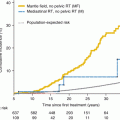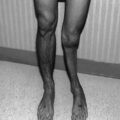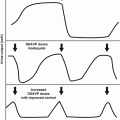Late effects
Causative treatment
Signs and symptoms
Screening and diagnostic tests
Management and intervention
Chemotherapy
Radiation
Surgery
Overt hypothyroidism (elevated TSH, decreased T4)
>20 Gy to the neck, cervical spine
>7.5 Gy TBI (total body irradiation)
Partial or complete thyroidectomy
Hoarseness
Fatigue
Weight gain
Dry skin
Cold intolerance
Dry brittle hair
Alopecia
Constipation
Lethargy
Poor linear growth
Menstrual irregularities
Pubertal delay
Bradycardia
Hypotension
Asymptomatic
Free T4, TSH annually
Plot on growth chart
Thyroxine replacement
Anticipatory guidance regarding symptoms of hyperthyroidism/hypothyroidism
Compensated hypothyroidism (elevated TSH, normal T4)
Same as overt hypothyroidism
Same as overt hypothyroidism
Asymptomatic
Free T4, TSH annually
Plot on growth chart
Thyroxine to suppress gland activity
Thyroid nodules
Same as overt hypothyroidism
Same as overt hypothyroidism
Free T4, TSH annually
Physical exam
Thyroid ultrasound
Biopsy/resection
Hyperthyroidism (decreased TSH, elevated T4)
Same as overt hypothyroidism
Nervousness
Tremors
Heat intolerance
Weight loss
Insomnia
Increased appetite
Diarrhea
Moist skin
Tachycardia
Exophthalmos
Goiter
Free T4, TSH annually
Physical exam T3, antithyroglobulin
Antimicrosomal
Antibody baseline, then prn symptoms
Refer to endocrinologist (PTU, propranolol, 131I thyroidectomy)
Table 2.2
Evaluation of patients at risk for late effects: CNS effects
Late effects | Causative treatment | Signs and symptoms | Screening and diagnostic tests | Management and intervention | ||
|---|---|---|---|---|---|---|
Chemotherapy | Radiation | Surgery | ||||
Neurocognitive deficit | High-dose IV MTX, IT MTX | >18 Gy | Resection of CNS tumor | Difficulty with reading, language, verbal/nonverbal memory, arithmetic, receptive, and expressive language Decreased speed of mental processing Attention deficit Decreased IQ Behavior problems Poor school attendance Poor hand-eye coordination | Neurocognitive testing: psychoeducational, neuropsychologic | Psychoeducation assistance |
Leukoencephalopathy | MTX Ara-C (IV or IT) | >18 Gy | Seizures Neurologic impairment Compare with premorbid status | MRI/CT scan baseline and symptoms | Symptom management: muscle relaxant Anticonvulsants Physical therapy Occupational therapy | |
Focal necrosis | MTX (IT or high-dose IV), BCNU, CDDP | >50 Gy (especially with >21 Gy daily fraction) | Resection of tumor | Headaches Nausea Seizures Papilledema Hemiparesis/other focal findings Speech, learning, and memory deficits | MRI/CT scan baseline, PRN symptoms, PET or SPECT scan | Steroid therapy Debulking of necrotic tissue |
Large-vessel stroke | >60 Gy | Headache Seizures Hemiparesis Aphasia Focal neurologic findings | CT scan/MRI Arteriogram | Determined by specific neurologic impairment | ||
Blindness | Intra-arterial BCNU, CDDP | RT (optic nerve chiasm, occipital lobe) | Resection of tumor | Progressive visual loss | Ophthalmic evaluation Visual evoked response | Visual aids |
Ototoxicity | CDDP, carboplatin | >50 Gy (middle/inner ear) | Abnormal speech Hearing loss | Conventional pure tone audiogram baseline and prn symptoms | Speech therapy Hearing aid Referral to ENT Feucher amplification | |
Myelitis | Ara-C (IT) | >45–50 Gy | Spinal cord surgery | Paresis Spasticity Altered sensation Loss of sphincter control | MRI | Steroids Physical therapy Occupational therapy |
Table 2.3
Evaluation of patients at risk for late effects: gastrointestinal
Late effects | Causative treatment | Signs and symptoms | Screening and diagnostic tests | Management and intervention | ||
|---|---|---|---|---|---|---|
Chemotherapy | Radiation | Surgery | ||||
Enteritis | Doxo and Act-D (RT enhancers) | >40 Gy | Abdominal surgery enhances RT effect | Abdominal pain Diarrhea Decreased stool bulk Emesis Weight loss Poor linear growth | Height and weight q yr Stool guaiac q yr, CBC with MCV q yr Total protein and albumin q 3–5 years (absorption tests, vitamin B12 level, and contrast studies) | Dietary management Refer to gastroenterologist |
Adhesions | RT enhances effect | Laparotomy | Abdominal pain Bilious vomiting Hyperactive bowel sounds | Abdominal radiograph | NPO Gastric suction Adhesion lysis | |
Fibrosis: esophagus (stricture) | Doxo and Act-D (RT enhancers) | >40–50 Gy | Abdomen | Dysphagia Weight loss Poor linear growth | Height and weight q yr, CBC q yr | Refer to GI |
Fibrosis: small intestines | >40 Gy | Abdomen | Abdominal pain Constipation Diarrhea Weight loss Obstruction | Height and weight q yr, CBC q yr (BA swallow/endoscopy prn) | Esophageal dilation Anti-reflux surgery | |
Fibrosis: large intestine, colon | >40 Gy | Abdomen | Abdominal colic Rectal pain Constipation Melena Weight loss Obstruction | Height and weight q yr Rectal exam Stool guaiac q yr Lower GI Colonoscopy Sigmoidoscopy | Stool softeners High-fiber diet | |
Table 2.4
Evaluation of patients at risk for late effects: hepatic
Late effects | Causative treatment | Signs and symptoms | Screening and diagnostic tests | Management and intervention | ||
|---|---|---|---|---|---|---|
Chemotherapy | Radiation | Surgery | ||||
Hepatic fibrosis/cirrhosis | MTX, Act-D 6MP, 6TG | >30 Gy | Major resection | Itching Jaundice Spider nevi Bruising Portal hypertension Esophageal varices Hemorrhoids Hematemesis Encephalopathy | LFTs q yr (hepatitis C screen, liver biopsy, endoscopy) | Hepatitis screen (hepatitis A, B, C, CMV) Diuretics Refer to hepatologist |
Table 2.5
Evaluation of patients at risk for late effects: genitourinary
Late effects | Causative treatment | Signs and symptoms | Screening and diagnostic tests | Management and intervention | ||
|---|---|---|---|---|---|---|
Chemotherapy | Radiation | Surgery | ||||
Glomerular dysfunction | CDDP, carboplatin, Ifos | >20 Gy or >15 Gy with chemotherapy | Asymptomatic or fatigue, poor linear growth, anemia, oliguria | Creatinine and BUN q yr Creatinine clearance baseline and q 3 years Annual: blood pressure Height, weight Hemoglobin Urinalysis | Low-protein diet Dialysis Renal transplant | |
Hypoplastic kidney/renal arteriosclerosis | 20–30 Gy or 10–15 Gy with chemotherapy | Fatigue Poor linear growth Hypertension Headache Edema Albuminuria Urinary casts | Same as glomerular dysfunction | Same as glomerular dysfunction | ||
Tubular dysfunction | CDDP, carboplatin, Ifos | Seizures (↓ Mg) Weakness (↓ Po4) Glycosuria Poor linear growth | Mg, Ca, PO4, Cr, BUN, Hg annually, BP/urinalysis q year, 24-h urine for Ca, Po4 prn for abnormalities | Mg supplement, Po4 supplement | ||
Nephrotic syndrome | 20–30 Gy | Proteinuria Edema | Serum protein, albumin, Cr, BUN, q year Urinalysis q yr Blood pressure q 1 (24-h urine for protein and Cr) | Low-salt diet Diuretics | ||
Bladder: fibrosis or hypoplasia, reduced bladder capacity | CPM, Ifos, surgical referral | >30 Gy prepubertal >50 Gy postpubertal | Urgency Frequency Dysuria Incontinence (nocturia) Pelvic hypoplasia | Urinalysis q yr Cystoscopy, IVP/US, volumetrics | Exercises to increase bladder capacity | |
Hemorrhagic and nonhemorrhagic cystitis | CPM, Ifos | 35 Gy (lower doses enhance chemotherapy effect) | Hematuria, or frequency, urgency, dysuria, bladder tenderness | Urinalysis q yr Cystoscopy if hematuria on 2 exams Hg q year | Refer to urologist Maintain Hg Antispasmodics Counsel regarding risk of bladder cancer | |
Prostate | 40–60 Gy (lower doses inhibit development; higher doses cause atrophy) | Decreased volume of seminal fluid Hypoplastic or atrophied prostate | Prostate examination q yr Semen analysis × 1 at maturity. Ultrasound | Counsel regarding possible infertility due to inadequate seminal fluid Monitor prostate (exam and prostate-specific antigen) | ||
Vagina: fibrosis/diminished growth | Act-D and doxo enhance RT effect | 4–60 Gy (lower doses inhibit development; higher doses cause atrophy) | Painful intercourse Vaginal bleeding Small vaginal vault | Pelvic exam (possibly under anesthesia), baseline during puberty and then prn for symptoms | Dilations Reconstructive surgery Potential need for cesarean section | |
Uterus: fibrosis/decreased growth | >20 Gy (prepubertal) >40–50 Gy (postpubertal) | Spontaneous abortion Low birth weight infants | Pelvic examination, prn for symptoms or if planning pregnancy | Counsel regarding pregnancy Refer to gynecologist if considering pregnancy | ||
Ureter: fibrosis | >50–60 Gy | Frequent UTIs Pelvic hypoplasia Hydronephrosis | Urinalysis q yr Urethrogram | UTI prophylaxis | ||
Urethra: strictures | >50 Gy | GU | Frequent UTIs Dysuria Stream abnormalities | Urinalysis q yr Voiding cystogram | UTI prophylaxis Surgical intervention | |
Table 2.6
Evaluation of patients at risk for late effects: head and neck
Late effects | Causative treatment | Signs and symptoms | Screening and diagnostic tests | Management and intervention | ||
|---|---|---|---|---|---|---|
Chemotherapy | Radiation | Surgery | ||||
Xerostomia (decreased salivary gland function) | Doxo and Act D (RT enhances) | >30 Gy (and >50 % of the gland must be radiated) | Decreased salivary flow Dry mouth Altered taste perception Dental decay Candida (thrush) | Dental examination Salivary flow studies Attention to early caries, periodontal disease | Encourage meticulous oral hygiene Saliva substitute Prophylactic fluoride Dietary counseling regarding avoiding fermentable carbohydrates Nystatin for oral candidiasis Pilocarpine | |
Intranasal scarring | >40 Gy | Chronic rhinosinusitis Nasal discharge Postnasal drip Facial pain Headache | Inspection of mucosa Nasopharyngoscopy | Decongestants Drainage procedures Antibiotics prn | ||
Epilation (scalp) | >15–20 Gy | Thinning of hair
Stay updated, free articles. Join our Telegram channel
Full access? Get Clinical Tree
 Get Clinical Tree app for offline access
Get Clinical Tree app for offline access

| ||||



